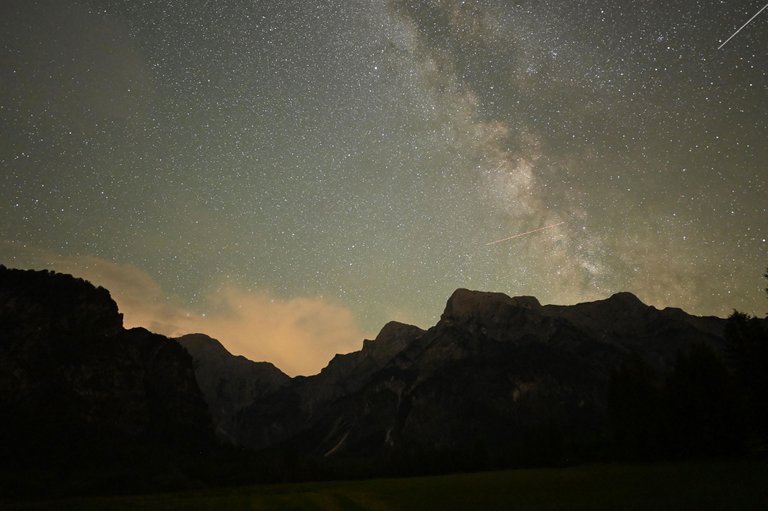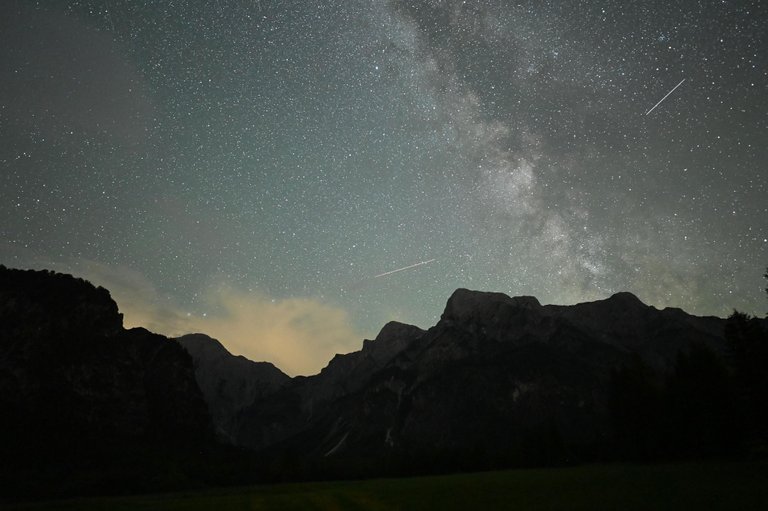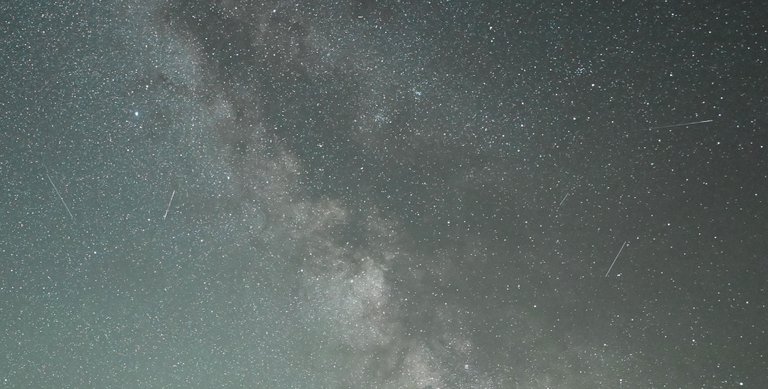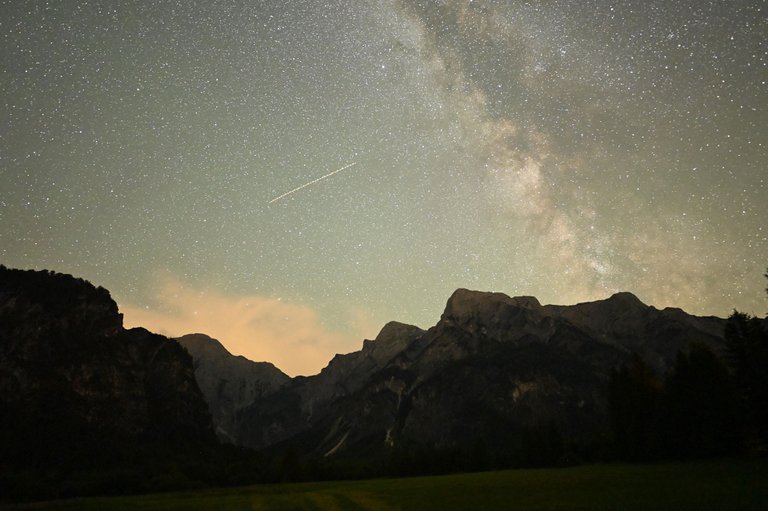I have to apologize, yesterday I was assuming that the strips of light in my pictures of the milky way were produced by Elon Musks Starlink or other satelites that orbit our Earth but actually yesterday I read that the Starshower of the Perseids is ongoing at the moment and most of the stripes originated from the starshower and not from Starlink.
That is why I am really happy that I managed to take some pictures of the starshower yesterday night too. Stefan and I visited another dark spot here in Austria and took several pictures of the starshower in front of the Milky Way in the night. There were also a lot of other people watching the starshower yesterday night with us and some of them also took some pictures of this spectacular event. Of course you need to find a spot where it is pretty dark in the night and were there is only very few artificial light.
It was a bit cloudy and some times the clouds interfered a bit with our photography but fortunately we only had very little distortion because of clouds.

Milky Way above the mountains and Starshower of the Persides in Upper Austria yesterday night . Picture: Florian Glechner.
| Camera used | Nikon Z6II |
|---|---|
| Lens used | Nikor Z 20 mm 1.8 lens |
| Filter used | none |
| Exposure Time | 15 Seconds |
| Aperture used | F1.8 |
| Focal Length | 20 mm |
| Time | 10:01 pm |
| ISO | 8000 |

Meteorshower of the Perseids. Picture: Florian Glechner.
| Camera used | Nikon Z6II |
|---|---|
| Lens used | Nikor Z 20 mm 1.8 lens |
| Filter used | none |
| Exposure Time | 15 Seconds |
| Aperture used | F1.8 |
| Focal Length | 20 mm |
| Time | 10:01 pm |
| ISO | 8000 |

Mountain with Milky Way in the background. Picture: Florian Glechner.
| Camera used | Nikon Z6II |
|---|---|
| Lens used | Nikor Z 20 mm 1.8 lens |
| Filter used | none |
| Exposure Time | 15 Seconds |
| Aperture used | F1.8 |
| Focal Length | 20 mm |
| Time | 10:01 pm |
| ISO | 8000 |

Starshower of the Persides. Picture: Florian Glechner.
| Camera used | Nikon Z6II |
|---|---|
| Lens used | Nikor Z 20 mm 1.8 lens |
| Filter used | none |
| Exposure Time | 15 Seconds |
| Aperture used | F1.8 |
| Focal Length | 20 mm |
| Time | 10:01 pm |
| ISO | 8000 |

Milky Way with Starshower of the Persides. Picture: Florian Glechner.
| Camera used | Nikon Z6II |
|---|---|
| Lens used | Nikor Z 20 mm 1.8 lens |
| Filter used | none |
| Exposure Time | 15 Seconds |
| Aperture used | F1.8 |
| Focal Length | 20 mm |
| Time | 10:01 pm |
| ISO | 8000 |
@janasilver denkt du hast ein Vote durch @investinthefutur verdient!
@janasilver thinks you have earned a vote of @investinthefutur !
$PIZZA slices delivered:
@janasilver(3/5) tipped @florian-glechner
Die Perseiden mit ihrem Maximum um den 12-13 August sind bei uns wegen der Lichtverschmutzung unterhalb von Cassiopeia nur schwer zu sehen.
Zudem lud die Nässe nicht dazu ein sich nach Mitternacht einfach auf die nächste Wiese zu legen...☹️
!invest_vote !LUV !PIZZA !wine !WITZ !LOLZ !HUGH
Oh schade, ich bin aber auch extra weit weg gefahren in die Berge, eben wegen der Lichtverschmutzung. In der Nähe von mir wäre es eh nicht gegangen eben wegen der Lichtverschmutzung.
View or trade
BEER.Hey @florian-glechner, here is a little bit of
BEERfrom @janasilver for you. Enjoy it!Did you know that <a href='https://dcity.io/cityyou can use BEER at dCity game to buy cards to rule the world.
Hab heute Nacht noch mal hochgeschaut. Einfach zu hell in NRW.
War letztes Jahr auch schon. Die Satelliten fliegen überschaubar langsam durchs Firmament. In 15 Sekunden schaffen die nicht solch eine Strecke wie die Meteore. Hab in meinem Leben insgesamt 3 Feuerbälle gesehen. Der erste war auch zugleich der größte und noch vor der Jahrtausend Wende.
War für Sekunden taghell und danach "glühte" die Atmosphäre...🤩
Beste Grüße
!BEER
Den Peak mit über 60 Sternschnuppen pro Stunde dürften wir heute Nacht für dieses Jahr erreicht haben...
https://www.imo.net/members/imo_live_shower/summary?shower=PER&year=2023